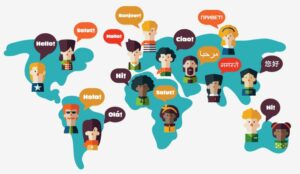Luke Turner shares with us the trials and tribulations of working in a multilingual contact centre.
I work abroad running the MI and WFP team in a contact centre that covers 11 different languages and multiple channels of communication, and having spent many years working in UK contact centres. I have had to adapt my management style and communication methods to suit an environment where confusion can be a real killer.
Separated by a common language
Now it’s true that most centres will have a “business language” – one language that is used as the standard communication for all employees. However, this relies on every single person speaking the language at the same level.
How many of you studied a foreign language at school? Now, how many of you have put that on your CV at some point?
So you’ve been hired by a French/German/Spanish company as you can speak the language. Could you explain a complicated shift pattern or dissect a 50-page end-of-year analysis in that language?
There are always people that can pick up and speak new languages fluently, but for most of us it takes time to adapt and the language skills we learnt at school don’t always cut it when you’ve got an irate customer or CEO shouting at you.
Avoid misinterpretation
The most important thing about managing and excelling in this environment is to avoid misinterpretation at all costs. You know what you mean but do they? It’s cutting out the misinterpretations that’s key!
A change in mindset – spend more time on the little things
You have to realise that although something is easy for you to understand it may not be to the people you’re explaining it to. It takes a lot of patience and flexibility. It’s not only the language that can be a hurdle but the way different nationalities interpret information, too. If I had to explain something to a team manager 4 times in the UK I would not be happy. However, when that person’s first language is not English you just have to take it on the chin and keep trying until they understand.
If someone’s not getting you, don’t just keep saying the same thing
If you really aren’t getting anywhere, try saying what you need to in a different way. Don’t just keep saying it over and over again – look at the words you’re using, could you re-phrase? Could you explain it from a different point of view? If you just keep going over the same thing again and again, all parties will just get frustrated and you will never get anywhere.
Visual aids (show and tell)
Visual aids work where you can show people what you’re talking about at the same time as you’re telling them about it.
The best example I can think of is when authorising a shift swap/holiday.
The easiest thing in the world is to tell the agent ‘I have swapped your shift from a 10-7 to an 11-8’ and on the outside this seems really basic – so you would send an email stating this. However, this leaves room for misinterpretation. But if you attach screen shots to the email then no matter what the level of English (as is the business language in my company’s case), the agent has a visual aid to refer to and is less likely to misunderstand.
I have used a really simple explanation but visual aids become more and more important the more complicated the subject you’re talking about is.
Slow down and think about how you speak
I get very passionate about what I do and if I am talking about something I feel strongly about I tend to speed up what I’m saying.
People increase the speed of their talking for many different reasons – excitement, nervousness, anger or just impatience. However, when you’re dealing with other nationalities this can cause big problems.
Again, think back to the languages you learnt at school – it was easy to understand when you had your teacher talking to you slowly and calmly. Now imagine they are excitedly burbling or angrily screaming at you. You will certainly get some of the info BUT you will miss parts/key words out and once again this will lead into the biggest trap…. misinterpretation.
Clear communication – explain, confirm, question
One of the biggest tips I can give you is ALWAYS make sure that people actually understand you by getting them to explain things back to you.
When I first started in a multilingual centre I would explain things to people as I did in the UK, then ask them if they understood. The answer was always “yes of course”.
Fast forward a few days and about a quarter of the time whatever I had asked for either hadn’t been done or had been done wrong.
Whether this is because people are afraid of looking like they don’t know what they’re doing or they genuinely think they understand what you’re talking about, it takes no time at all to quickly re-confirm at the end of a conversation and I promise you’ll be surprised at how often things are initially misunderstood.
Remember regional accents/phrases
The UK is linguistically a massively diverse place. Look at the difference in accents between, say, Cornwall and Liverpool or London and Scotland. Remember that people whose second language is English will have learnt it in a very specific way so you may need to slow down your speech and drop all the regional sayings.
It took one of my colleagues 3 weeks to ask me what “ta” meant (it means thanks). During that time I thought I’d been saying thank you every time he had completed something I’d asked for – whereas he thought I never said thank you for anything!
Borrow people
There are always people around you who have a better grasp of the language, so if there’s a real communication breakdown don’t be afraid to grab one of them.
I have pulled agents off the phones for 5mins to ensure we get through a particularly complicated conversation (though just bear in mind what the topic is – you don’t want a confidential discussion all over the floor!).
Explain buzzwords, abbreviations and industry lingo
Using industry lingo and abbreviations is something everybody does, in fact I’ve done it in this article already (MI/WFP instead of Management Information and Workforce Planning), but with different languages the problem is magnified 10-fold as different nationalities have their own abbreviations. So in a meeting with 5 different nationalities it doesn’t matter if they all speak English if everyone’s abbreviating differently. Agree on an office standard definition.
Communication tools – Google translate
I use Google translate every day – it’s not the most in-depth translator but it’s quick, easy and, most importantly, free and certainly helps me out with the more basic requests that come in other languages.
Try and pick up parts of the languages you work with
Even if the business language is English you will be amazed how much people open up if you even try and talk to them in their own language. Just showing them you’re making the effort can make a big difference.

Luke Turner
I work with 11 different languages so there’s no way I could learn them all, but just knowing how to say please/thanks can really make people feel special and helps build important relationships.
So, if you where thinking about applying for a job abroad, hiring staff who have English as their second language or wanting to work with foreign companies don’t be put off by the potential language barriers.
Just be prepared to change the way you work a little, think about things that are second nature to you and learn as you go along. In the long run, the interesting environment and diversity far outweighs any minor frustrations you may run into with the language.
Luke Turner runs a Management Information and Workforce Planning Group in a contact centre in Malta.
Author: Jo Robinson
Published On: 7th Dec 2011 - Last modified: 24th Feb 2025
Read more about - Expert Insights, Customer Service, CX, Language, Rapport








































